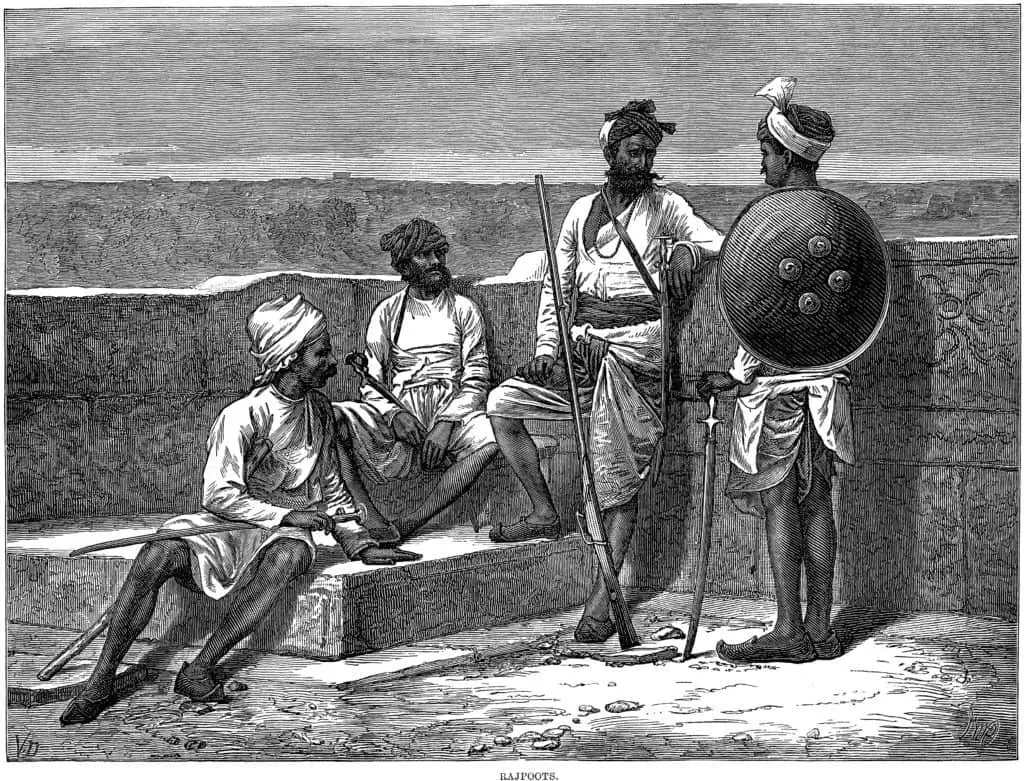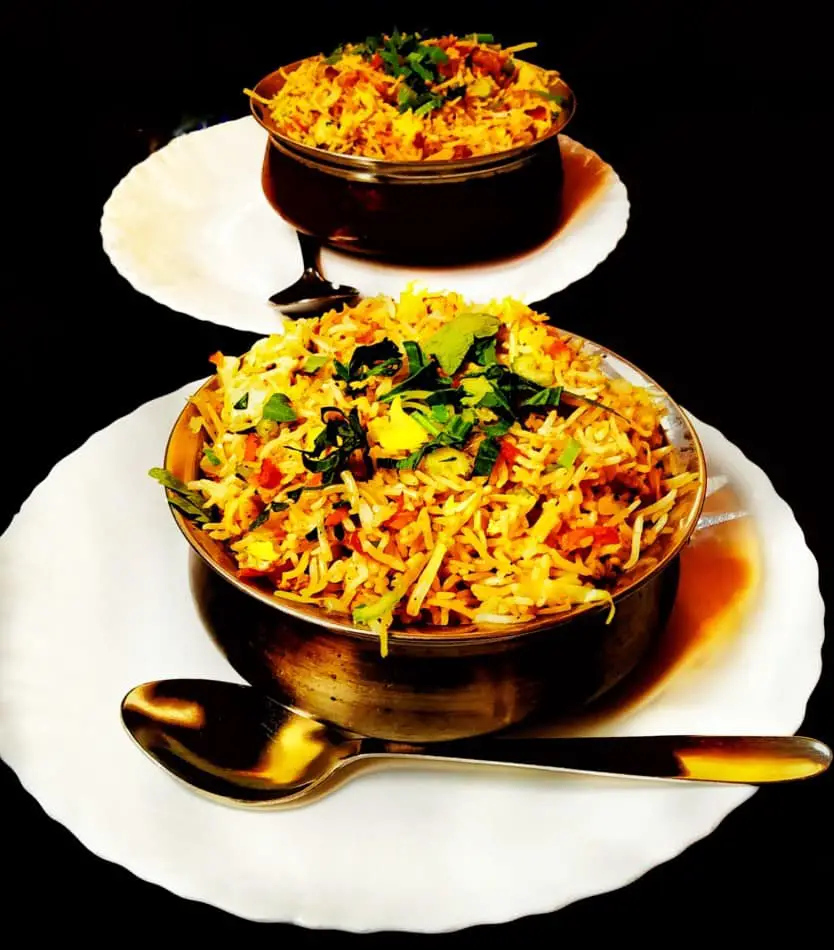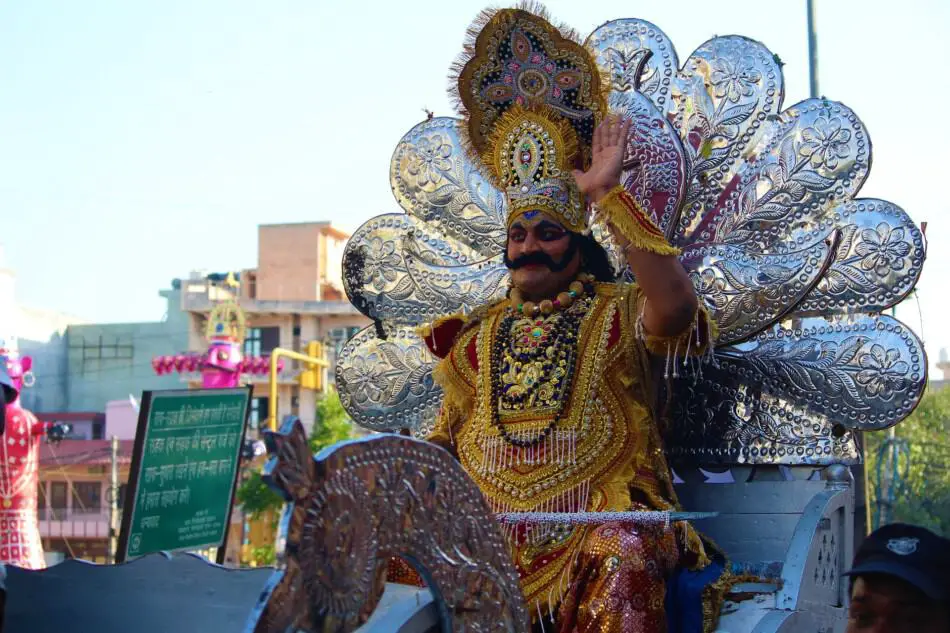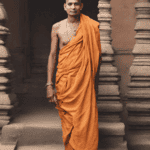Kshatriyas are the highest caste after Brahmins in the Hindu caste system. They were the warriors and rulers. They are mostly located in the northern part of India. They are believed to have emerged from Lord Brahma’s arms. They normally eat meat and can intake liquor too, this quality differentiates them with the Brahmins. The best known Kshatriyas are the Rajputs. They used to study under the guidance of Brahmin teachers. Gautam Buddha and Mahavir Jain, both were born into Kshatriya families. Lord Krishna is also believed to be a Kshatriya. According to Hindu texts, all the castes are given a particular color. The Brahmins are given white color, the Kshatriyas are given red, the Vaishyas are given yellow color while the Shudras were given black color. Kshatriyas were given red color because red color is a symbol of rajas (energetic personality). To get easily identified, all the castes were told to use a specific surname. Brahmins were told to use ‘Sharma’, Kshatriyas were told to use ‘Varma’, Vaishyas were told to use ‘Gupta’ while the Shudras were told to use ‘Dasa’ as their surnames respectively.
When the caste system was implemented, Kshatriyas could be considered most powerful among all the castes of the Hindu caste system because the kings or rulers and all the warriors used to be Kshatriyas only. Their responsibility was to protect the citizens of their kingdom and govern the land. But now, no caste can be considered the most powerful. Each and every caste is equally powerful.

Kshatriya’s History
1. Mythological View
According to the Rigveda, there was a cosmic primal human (Purusha). His body was asked to go through primordial sacrifice so that, men and women, different castes and the world could be created. The Brahmins were believed to have emerged from his mouth, Kshatriyas from his arms, Vaishyas from his thighs and Shudras from his feet. His skull made the heaven, his eyes made the sun and the moon was made from his spirit.
2. Historical View
Around 1500 BC, the Aryans ( Indo – European invaders ) migrated to the Indian subcontinent. Aryans started taking control of the northern part of India. They maintained contacts only with the Austroloids and the Dravidians and not with the local people at all. To rule easily and in an organized way, the Aryans made three groups. The first group was called Kshatriya, they were the warriors. The second group comprised of the priests and teachers who were given the name of Brahmins. The third group was of merchants and craftsmen, they were known as Vaishyas. All the people outside these three groups were put in the category of Shudras. There was a fight running between the Kshatriyas and the Brahmins to decide the ruler. Kshatriyas won and then, they were the warriors as well as the rulers.
Do Kshatriyas Wear the Sacred Thread?
Just like Brahmins, Kshatriyas also wear the sacred thread known as ‘Janeu’ or ‘Janai’ after the Upanayana ceremony. It is related to the twin born concept known as the dvija concept. They wear the sacred thread made up of cotton. It is made up of three threads in a loop form and they wear it over their one shoulder going across their chest and under the other arm. It is believed that the janeu wearer is born two times. First, by his mother and second, when he wears the janeu. Thus, after wearing the janeu, they are considered reborn. Only after wearing the janeu they get the right to start their studies. It is also a symbol of the transformation or development of a male, from a young boy to a mature man.
Kshatriya’s Food Habits

Kshatriyas are allowed to eat non-vegetarian food and to consume liquor.
According to Ramayana of Valmiki, they are allowed to eat only the porcupine, the lizard, the turtle, the rabbit and the hedgehog among the five-toed animals.
According to Vaishanava dharamasastra, if they eat any five-toed animal other than the upper mentioned animals, they should fast for seven days. Some people say that Kshatriyas did not eat non-vegetarian food because they liked it but they used to eat non-vegetarian food because it helped them to develop cruelty in them which was needed to fight on the battlefield. Some Kshatriyas prefer to eat only vegetarian food also.
Sub-castes in Kshatriya
They are believed to be the descendants of the Sun, the Moon or the Fire. The descendants of the Sun are known as the Suryavanshi, the descendants of the Moon are known as the Chandravanshi while the descendants of the Fire are known as the Agnivanshi. There is also the Nagavansh who was started by the grandson of a king who belonged to the Suryavanshi community. There is proof that these communities further have 62 descendants in total.
Some most common Kshatriya surnames are:
- Suryavanshi
- Gehlot
- Sisodiya
- Kushwaha
- Rathore
- Somvanshi
- Yaduvanshi
- Tomar
- Parihar
- Solanki
- Bhadoriya
- Gautam
- Gupta
- Kaushik
- Pal
- Dahiya
- Dogra
Kshatriya Dharma
According to Bhagavad Gita, based on their social traits, they should have some particular dharma (qualities). People who follow these dharmas are called Kshatriya.

These qualities include:
- Fame
- Courage
- Patience
- Giving charity to needy
- To worship God
- To protect citizens of their kingdom
- To not quit a war out of fear of the enemy
All Rajputs are Kshatriya But All Kshatriyas are Not Rajput
Rajputs come under the Kshatriya caste. They are the most common Kshatriya caste among all the Kshatriya castes. Rajputs are believed to be invaders who became integrated among Indian society. They became politically important during the s7th century. From around 800 AD, they ruled the northern part of India. For about 500 years, they defended kingdoms from invaders and conquered others because they were the warriors. In 1947, when the British rule ended, the Britishers recruited Rajputs into their military units. They are found all across the country but they are concentrated at in Rajasthan.
Some Renowned Kshatriyas
Armed Forces of India
- Brigadier Sawai Bhawani Singh, Maharaja of Jaipur awarded Mahavir Chakra.
- Major Shaitan Singh, awarded Param Vir Chakra for service in the 1962 India-China war.
- Naik Jadu Nath Singh Rathore awarded Param Vir Chakra for service in the Indo-Pakistani War of 1947.
- Brigadier Hari Singh Deora of Galthani (Pali, Rajasthan), awarded A.V.S.M.
- Colonel Saurabh Singh Shekhawat, the most decorated serving officer in the Indian Army.
- Company Havaldar Major Piru Singh Shekhawat, posthumously awarded the Param Vir Chakra, India’s highest award for valor in the face of the enemy.
- Lt. General Hanut Singh Rathore of Jasol was awarded Mahavir Chakra.
- General Maharaj Shri Rajendrasinhji Jadeja was the first Chief of Army Staff of the Indian army.
- Lieutenant General Sagat Singh, PVSM (14 July 1918 – 26 September 2001) was a three-star General in the Indian Army notable for his participation in the liberation of Goa and later in Bangladesh.
- Lieutenant-General Kanwar Bahadur Singh of Palaitha, MBE, (5 August 1910 – 8 May 2007) was a senior officer in the Indian Army.
- Admiral Madhvendra Singh of Chomu was Chief of Naval Staff of the Indian Navy between 29 December 2001 and his retirement from service on 31 July 2004.
- Lt. Gen. Nathu Singh Rathore of Gumanpura (Dungarpur).
- Colonel Rajyavardhan Singh Rathore is a Veteran Indian shooter and politician (union minister), who rose to fame after winning the Silver Medal in Men’s Double Trap at the 2004 Summer Olympics in Athens
and many more…
Sports and Athletics
- Kumar Shri Ranjitsinhji, Indian Test cricketer, ruler of Nawanagar from 1907 to 1933. Ranji Trophy was named in his honor.
- Major Dhyan Chand, winner of three Olympic gold medals (1928, 1932, and 1936) in field hockey and widely considered as the greatest field hockey player of all time.
- Rajyavardhan Singh Rathore, an Indian shooter and politician, who rose to fame after winning the Silver Medal in Men’s Double Trap at the 2004 Summer Olympics in Athens.
- Mahendra Singh Dhoni, Indian cricketer and current caption of team India from 2007.
- Raj Singh of Dungarpur, former President of BCCI.
- Ravindra Jadeja, Indian cricketer.
- Ajay Jadeja, a former cricketer who played between 1992 and 2000, playing in 15 Test matches and 196 One Day Internationals.
- Kumar Shri Duleepsinhji of Nawanagar, a cricketer who played for England.
- Chetan Chauhan, a former cricketer who played 40 Test matches for India.
- Kunwar Digvijay Singh, popularly known as “Babu”, was an Indian field hockey player, born in Barabanki, Uttar Pradesh.
- Jaspal Rana, an Indian shooter who was a gold medallist at the 1994 Asian Games, 1998 Commonwealth Games, 2002 Commonwealth Games, 2006 Commonwealth Games, and 2006 Asian Games
and many more.
Rulers
- Amar Singh Rathore of Nagaur.
- Bappa Rawal, the founder of the Mewar Dynasty.
- Chatrapati Shivaji, the founder of the Maratha Empire.
- Durgadas Rathore of Mewar.
- Jai Singh I, King of Amber.
- Jai Singh II, founder, and King of Jaipur.
- Jai Singh Prabhakar Bahadur, Ruler of the princly state of Alwar.
- Maharaja Sir Ganga Singh of Bikaner.
- Maharaja Gulab Singh, who became the first Maharaja of Jammu and Kashmir.
- Maharaja Hari Singh, the last ruler of Jammu & Kashmir (princely state).
- Maharaja Jaswant Singh of Marwar.
- Maharana Pratap of Mewar.
- Maharao Shardul Singh, ruler of Jhunjhunu.
- Maldeo Rathore of Marwar.
- Prithviraj Chauhan, King of Ajmer.
- Raja Man Singh I of Amber, King of Amber, Rajasthan, and General of Akbar.
- Raja Bhagwant Das, King of Amber Rajasthan
and many more…
Politicians
- Vishwanath Pratap Singh (25 June 1931 – 27 November 2008) of Manda, Indian politician, and government official was the Prime Minister of India (1989–90).
- Chandra Shekhar Singh (1 July 1927 – 8 July 2007), was the Prime Minister of India for seven months.
- Bhairon Singh Shekhawat (23 October 1923 – 15 May 2010) of Khachariawas, was the 11th Vice-President of India.
- Jaswant Singh (born 3 January 1938) of Jasol. He earlier belonged to the Bharatiya Janata Party and has held many portfolios in the national cabinet including Finance, External Affairs and Defence during the NDA regime (1998 to 2004)
- Virbhadra Singh (born 23 June 1934) of Bashahr, is an Indian politician who has been the Chief Minister of Himachal Pradesh since 2012.
- Digvijaya Singh (born 28 February 1947) of Raghogarh, is an Indian politician and a Member of Parliament in the Rajya Sabha.
- Vir Bahadur Singh was an Indian politician belonging to Indian National Congress. He was Chief Minister of Uttar Pradesh and Minister of Communications.
- Arjun Singh (5 November 1930 – 4 March 2011) of Churhat, was an Indian politician from the Indian National Congress party.
- Raman Singh (born 15 October 1952) is an Indian politician and is the Chief Minister of Chhattisgarh state since 7 December 2003.
- Shankersinh Vaghela (born 21 July 1940) is an Indian politician belonging to Indian National Congress.
- Madhav Singh Solanki is a leader of Indian National Congress party and a former External Affairs Minister of India.
- Rajnath Singh (born 10 July 1951) is an Indian politician belonging to the Bharatiya Janata Party (BJP).
and many more…
Actors
- Sanjay Dutt
- Sunny Deol
- Dharmendra
- Vinod Khanna
- Raveena Tondon
- Sunil Dutt
- Prem Chopra
- Kabir Bedi
- Divya Bharti
- Meenakshi Seshadri
- Vijayendra Ghatge
- Puneet Issar
- Kangana Ranaut
- Preity Zinta
- Sonarika Bhadauria
and many more…
Famous Kshatriya during and before the 18th Century
- Chatrapati Shivaji
- Maharaja Jai Singh I
- Maharaja Jai Singh II
- Prithviraj Chauhan
- Raja Man Singh I
- Rao Jodha
- Maharani Padmini
and many more..
Ruling Kshatriya Dynasties of India
- Janjua Rajput Hindushahi
- Chauhan dynasty of Ajmer & Delhi
- Solanki dynasty
- Paramara dynasty of Malwa
- Parihara dynasty of Kannauj
- Bargujar/Badgurjar dynasty of Rajorgarh
- Chandelas of Khajuraho
- Gahadvalas of Kannauj
- Chand dynasty of Kumaon
- Jarrals of Kalanaur and Jammu & Kashmir
- Katoch dynasty of Kangra
- Bundelas of Bundelkhand
- Tomaras of Delhi & Gwalior
- Pathanias of Nurpur
- Sisodias of Mewar
- Kachwahas of Jaipur
- Rathores of Marwar
and many more…
Reservation System for Kshatriya
There is a caste-based reservation system in India. Kshatriyas belong to the general or unreserved caste. But in some states, they belong to the other backward caste also. According to the central government, the three categories, the scheduled caste, the scheduled tribes, and the other backward castes are given reservation in educational institutes as well as for jobs. The scheduled caste comprises 15% of the Indian population. 15% of seats in educational institutes and 15% of jobs are reserved for them. The scheduled tribe comprises 7.5% of the Indian population and 7.5% seats in educational institutes and jobs are reserved for them. The other backward castes comprise of 50% of the Indian population but the seats in educational institutes and jobs that are reserved for them are 27%. Recently, the Indian government announced a 10% reservation for the economically weaker sections of the society as well. The state government also provides reservation to all these classes but the percentage of reservation varies according to the population of all these categories in different states.
